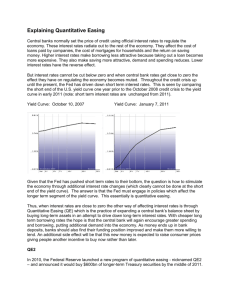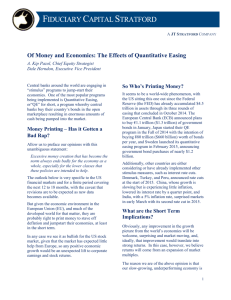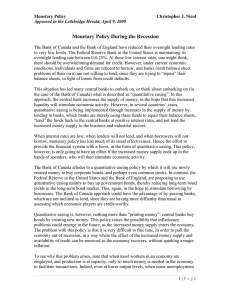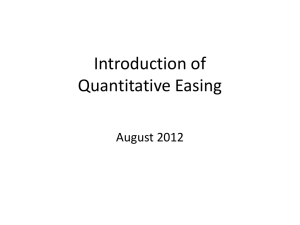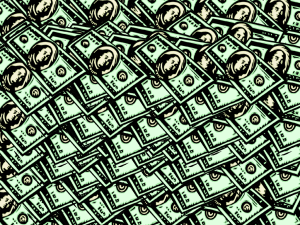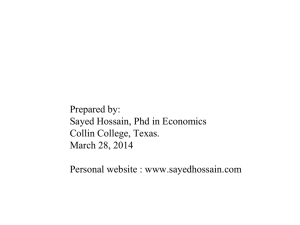Quantitative easing
advertisement
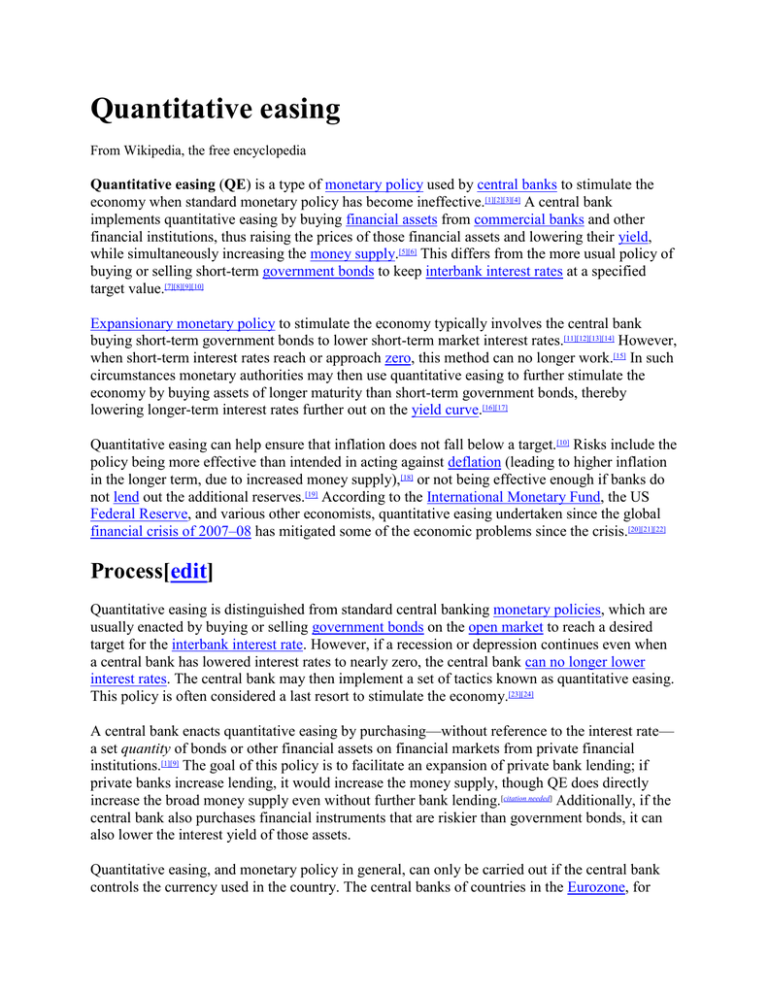
Quantitative easing From Wikipedia, the free encyclopedia Quantitative easing (QE) is a type of monetary policy used by central banks to stimulate the economy when standard monetary policy has become ineffective.[1][2][3][4] A central bank implements quantitative easing by buying financial assets from commercial banks and other financial institutions, thus raising the prices of those financial assets and lowering their yield, while simultaneously increasing the money supply.[5][6] This differs from the more usual policy of buying or selling short-term government bonds to keep interbank interest rates at a specified target value.[7][8][9][10] Expansionary monetary policy to stimulate the economy typically involves the central bank buying short-term government bonds to lower short-term market interest rates.[11][12][13][14] However, when short-term interest rates reach or approach zero, this method can no longer work.[15] In such circumstances monetary authorities may then use quantitative easing to further stimulate the economy by buying assets of longer maturity than short-term government bonds, thereby lowering longer-term interest rates further out on the yield curve.[16][17] Quantitative easing can help ensure that inflation does not fall below a target.[10] Risks include the policy being more effective than intended in acting against deflation (leading to higher inflation in the longer term, due to increased money supply),[18] or not being effective enough if banks do not lend out the additional reserves.[19] According to the International Monetary Fund, the US Federal Reserve, and various other economists, quantitative easing undertaken since the global financial crisis of 2007–08 has mitigated some of the economic problems since the crisis.[20][21][22] Process[edit] Quantitative easing is distinguished from standard central banking monetary policies, which are usually enacted by buying or selling government bonds on the open market to reach a desired target for the interbank interest rate. However, if a recession or depression continues even when a central bank has lowered interest rates to nearly zero, the central bank can no longer lower interest rates. The central bank may then implement a set of tactics known as quantitative easing. This policy is often considered a last resort to stimulate the economy.[23][24] A central bank enacts quantitative easing by purchasing—without reference to the interest rate— a set quantity of bonds or other financial assets on financial markets from private financial institutions.[1][9] The goal of this policy is to facilitate an expansion of private bank lending; if private banks increase lending, it would increase the money supply, though QE does directly increase the broad money supply even without further bank lending.[citation needed] Additionally, if the central bank also purchases financial instruments that are riskier than government bonds, it can also lower the interest yield of those assets. Quantitative easing, and monetary policy in general, can only be carried out if the central bank controls the currency used in the country. The central banks of countries in the Eurozone, for example, cannot unilaterally expand their money supply and thus cannot employ quantitative easing. They must instead rely on the European Central Bank (ECB) to enact monetary policy.[25] History[edit] Precedents[edit] Some economists and commentators have argued that the US Federal Reserve used a form of quantitative easing in the 1930s and 1940s to fight the Great Depression.[26][27][28][29][30] Nonetheless, since the Federal Reserve instituted quantitative easing programs after the global 2007-2008 financial crisis, its actions have repeatedly been called "unprecedented" by pundits and news sources.[31][32][33] At least one professional commentator has created a chart to point out that, as a percentage of GDP, the Federal Reserve's post-financial crisis balance sheet had still not, as of May 2013, exceeded the percentages reached between approximately 1939 and 1948.[34] After 2007[edit] Since the advent of the global financial crisis of 2007–08, policies similar to those undertaken by Japan have been used by the United States, the United Kingdom, and the Eurozone. Quantitative easing was used by these countries because their risk-free short-term nominal interest rates were either at or close to zero. In the United States, this interest rate is termed the federal funds rate; in the United Kingdom, it is termed the official bank rate. During the peak of the financial crisis in 2008, the US Federal Reserve expanded its balance sheet dramatically by adding new assets and new liabilities without "sterilizing" these by corresponding subtractions. In the same period, the United Kingdom also used quantitative easing as an additional arm of its monetary policy to alleviate its financial crisis.[43][44][45] US QE1, QE2, and QE3 [edit] Federal Reserve Holdings of Treasury Notes (blue) and Mortgage-Backed Securities (red) The US Federal Reserve held between $700 billion and $800 billion of Treasury notes on its balance sheet before the recession. In late November 2008, the Federal Reserve started buying $600 billion in mortgage-backed securities.[46] By March 2009, it held $1.75 trillion of bank debt, mortgage-backed securities, and Treasury notes; this amount reached a peak of $2.1 trillion in June 2010. Further purchases were halted as the economy started to improve, but resumed in August 2010 when the Fed decided the economy was not growing robustly. After the halt in June, holdings started falling naturally as debt matured and were projected to fall to $1.7 trillion by 2012. The Fed's revised goal became to keep holdings at $2.054 trillion. To maintain that level, the Fed bought $30 billion in two- to ten-year Treasury notes every month.[47] In November 2010, the Fed announced a second round of quantitative easing, buying $600 billion of Treasury securities by the end of the second quarter of 2011.[48][49] The expression "QE2" became a ubiquitous nickname in 2010, used to refer to this second round of quantitative easing by US central banks.[50] Retrospectively, the round of quantitative easing preceding QE2 was called "QE1".[51][52] A third round of quantitative easing, "QE3", was announced on 13 September 2012. In an 11–1 vote, the Federal Reserve decided to launch a new $40 billion per month, open-ended bond purchasing program of agency mortgage-backed securities. Additionally, the Federal Open Market Committee (FOMC) announced that it would likely maintain the federal funds rate near zero "at least through 2015."[53][54] According to NASDAQ.com, this is effectively a stimulus program that allows the Federal Reserve to relieve $40 billion per month of commercial housing market debt risk.[55] Because of its open-ended nature, QE3 has earned the popular nickname of "QE-Infinity."[56] On 12 December 2012, the FOMC announced an increase in the amount of open-ended purchases from $40 billion to $85 billion per month.[57] On 19 June 2013, Ben Bernanke announced a "tapering" of some of the Fed's QE policies contingent upon continued positive economic data. Specifically, he said that the Fed could scale back its bond purchases from $85 billion to $65 billion a month during the upcoming September 2013 policy meeting.[58][not in citation given] He also suggested that the bond-buying program could wrap up by mid-2014.[59] While Bernanke did not announce an interest rate hike, he suggested that if inflation followed a 2% target rate and unemployment decreased to 6.5%, the Fed would likely start raising rates. The stock markets dropped by approximately 4.3% over the three trading days following Bernanke's announcement, with the Dow Jones dropping 659 points between 19 and 24 June, closing at 14,660 at the end of the day on 24 June.[60] On 18 September 2013, the Fed decided to hold off on scaling back its bond-buying program,[61] and later began tapering purchases the next year—February 2014.[62] Purchases were halted on 29 October 2014[63] after accumulating $4.5 trillion in assets.[64] Effectiveness[edit] According to the International Monetary Fund (IMF), the quantitative easing policies undertaken by the central banks of the major developed countries since the beginning of the late-2000s financial crisis have contributed to the reduction in systemic risks following the bankruptcy of Lehman Brothers. The IMF states that the policies also contributed to the improvements in market confidence and the bottoming-out of the recession in the G7 economies in the second half of 2009.[20] Economist Martin Feldstein argues that QE2 led to a rise in the stock market in the second half of 2010, which in turn contributed to increasing consumption and the strong performance of the US economy in late 2010.[22] Former Federal Reserve Chairman Alan Greenspan calculated that as of July 2012, there was "very little impact on the economy."[88] Federal Reserve Governor Jeremy Stein has said that measures of quantitive easing such as large-scale asset purchases "have played a significant role in supporting economic activity".[21] According to Neil Irwin, senior economic correspondent at The New York Times, quantitative easing by the US Federal Reserve likely contributed to: i) Lower interest rates for corporate bonds and mortgage rates, helping support housing prices; ii) Higher stock market valuation, in terms of a higher price-earnings ratio for the S&P 500 index; iii) Increased inflation rate and investor's expectations for future inflation; iv) Higher rate of job creation; and v) Higher rate of GDP growth.[89]
